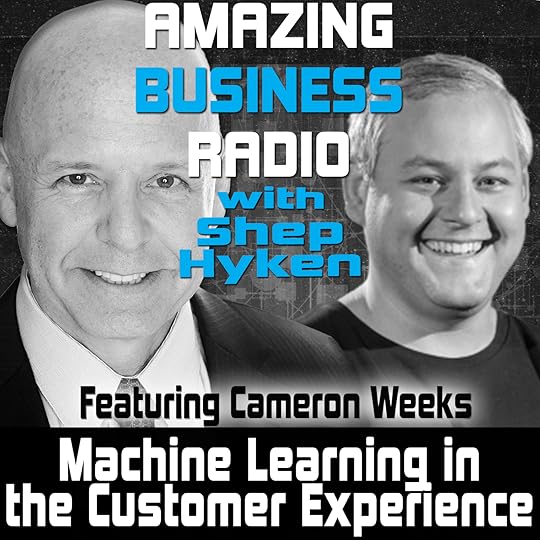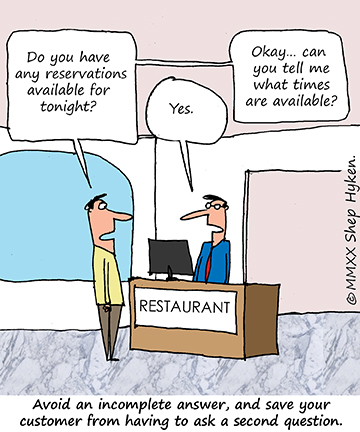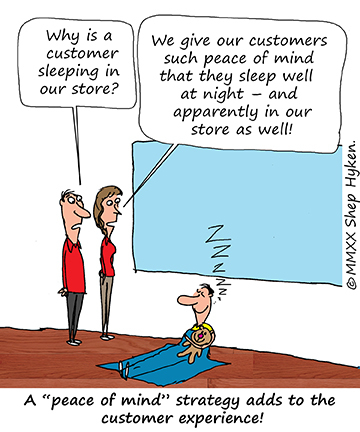Shep Hyken's Blog, page 105
May 27, 2020
The Incomplete Answer
I recently wrote about the expected experiences gap, where the customers’ expectations—based on the experiences they have with their favorite companies—are higher than what they receive from the company they are currently doing business with.
We heard from one of our Shepard Letter subscribers, Jared Lender, who gave us another example of a gap, one that results from incomplete information. In other words, it’s the gap between the answer the customer received the first time they asked and the answer they should have received.
This may have happened to you. You reach out to a salesperson or customer support agent with a problem or a question. They give you an answer, but you find yourself having to reach out again—only to find out there was more to the answer than what they originally told you. That’s exactly what happened to Jared, although he didn’t call back—the gap in information caused him to walk. Here’s the short version of the story.
After searching a company’s website for video tutorials on how to use their products, Jared reached out to them through their contact form with a question. He asked, “Do you know of any videos or instructions that can help get me going on a project?”
Several hours later the company’s customer service rep responded, “There are several videos about using our parts and products. They are posted by customers. Thank you for your interest.”
Good to know! There are videos posted by customers. However, it would have been nice to know where to find those videos. Jared immediately recognized the gap between a complete answer and the answer he received. Where were those videos? Were they on the company’s website? Were they on YouTube? Why couldn’t the customer service rep give Jared the links to the videos?
The answers to those questions don’t really matter. What does matter is that the answer caused additional friction for Jared—and potentially for the agent, as well. First, the answer could have sent Jared on a time-consuming search for the videos. Second, the answer could have caused Jared to reach out a second time with a follow-up question, requiring the agent to complete the response they should have shared in the first interaction. The result is a waste of time for both.
When there is a problem or question, take the time to answer it thoughtfully and completely. Ask the customer if they understand your response and if they have any other questions. In short, be proactive about giving a complete answer—the answer the customer deserves the first time they ask.
Shep Hyken is a customer service expert, keynote speaker, and New York Times bestselling business author. For information, contact 314-692-2200 or www.hyken.com. For information on The Customer Focus™ customer service training programs, go to www.thecustomerfocus.com. Follow on Twitter: @Hyken
(Copyright © MMXX, Shep Hyken)
The post The Incomplete Answer appeared first on Shep Hyken.
May 26, 2020
Amazing Business Radio: Cameron Weeks

Machine Learning in the Customer Experience
How to Utilize Technology to Create a Better Customer Experience
Shep Hyken interviews Cameron Weeks. They discuss strategies for improving both the employee experience and the customer experience using machine learning technology.








Top Takeaways:
Many customers believe that companies don’t care about customer service. If this were true, the customer support center or department would not exist. However, companies don’t often have the technological tools to provide a great experience.
The customer support department and contact centers have undergone a change over the past decade. They are no longer viewed as a cost, but a source of profit.
Frontline customer service agents have valuable information and data about the customer. Ideally, this information will trickle up to management and leadership to further improve CX.
The life of a customer service representative can be difficult and there is often a high turnover rate in these positions. Sources of difficulty and stress include upset customers, a lack of resources and frustration with the technology they are using (the need to switch between too many programs).
Companies need to examine what they ask of their CX agents and work to eliminate points of difficulty and stress. If agents are treated better, they will treat customers better.
It is crucial for companies to adopt an omnichannel system for customer communication. This allows for customers to have a single conversation with a company that spans over multiple channels, rather than a separate conversation on each channel.
Machine learning and similar technology is now a requirement to deliver a good customer experience.
Technology can assist companies in proactive service—reaching out to customers before a problem arises.
Before deploying machine learning, AI and other tech to your customers, utilize it internally first. Use new technology to create a better employee experience, and it will result in a better customer experience down the line.
Quotes:
“Machine learning is not an option in customer service anymore. It is a requirement.”
“Customer support and contact centers have shifted from being a cost center to being a profit center. It’s how you retain and grow a customer base.”
“We need to look at what we’re asking agents to do and start removing the clutter and simplifying the process of how we help people help people.”
About:
Cameron Weeks is co-founder and CEO of Edify Labs. He guides the team to think and act differently when it comes to changing the way companies connect with their customers and employees interact with each other.
Shep Hyken is a customer service and experience expert, New York Times bestselling author, award-winning keynote speaker, and your host of Amazing Business Radio.
The post Amazing Business Radio: Cameron Weeks appeared first on Shep Hyken.
May 25, 2020
5 Top Customer Service Articles For the Week of May 25, 2020
Each week I read a number of customer service and customer experience articles from various resources. Here are my top five picks from last week. I have added my comment about each article and would like to hear what you think too.
How to calculate your customer retention rate by Bryce Baer
(Zendesk) Churn happens. But a company shouldn’t run from its churn rate. Rather, consider it a key metric to guide and improve customer retention strategy and retention rate
My Comment: With all the ways to measure “customer satisfaction,” such as NPS, CSAT, customer effort, and many more, I’ve always felt the most important measurement is if the customer comes back. I was glad to see this article, which includes the formula to measure customer retention. I do want to remind you that a repeat customer is not a loyal customer. You still want to know why they came back.
7 Effective Ways to Use Video in Email Marketing by Téa Liarokapi
(Business2Community) Email marketing and video are two services that can be combined and provide great results, because one is engaging and the other is cost-effective. What’s more, email marketing is the most affordable way to reach different audiences, as well as one of the easiest to measure.
My Comment: I’m a big believer in using video to enhance the customer experience. Video tutorials can give customers a visual description of what they need. It’s a great way to showcase the best ways to use your product. And, if customer service and CX are marketing strategies, video can help in even more ways than you might think. Take a look at seven ways to use video in email marketing.
How Contact Centers are Responding to the COVID-19 Crisis by Jason Sterns
(Transparent BPO) Now that some time has passed, we decided to scour the web to see what trends are taking place in the industry, how companies are responding to the COVID-19 crisis concerning their customer service contact centers, and what advice they may have for the rest of us. Here are the results of our search.
My Comment: Contact centers need to understand their way of doing business has changed – in some cases dramatically – in the past two months. I was talking with an executive who runs 62 contact centers with 60,000 agents. At the beginning of the pandemic, he had to move every one of those employees to work from home – in less than one week! Yet, the “new normal” in the contact center world is more than just remote workers.
Four Ways To Deliver Better Customer Experience During The Pandemic by Athina Mallis
(WHICH-50) Riccardo Pasto highlighted four key ways brands can deliver better customer experiences through the turbulent times: through empathy, customer value, conducting a CX ecosystem impact analysis, and ongoing communication.
My Comment: I was intrigued by this article, which shares four ideas on how to manage customer service and CX in the midst of a crisis from Riccardo Pasto, head of CX research at Forrester. Empathy, customer value, managing the “ecosystem” and communication; all of these are sound strategies during a crisis like COVID-19, and they will work in good times, as well.
10 Tactics For More Effectively Measuring Your Customer Service ROI by YEC
(Forbes) The members of Young Entrepreneur Council share 10 ways you can make your customer service ROI figures measurable and impactful.
My Comment: Our first article in this week’s Top Five Roundup focused on how to measure customer retention. Our friends at the Young Entrepreneur Council have shared 10 ways to get the most of how you measure customer service ROI. Take a close look at number two, which is about looking at repeat customer behavior. Note from me: There is a difference between repeat customers and loyal customers. Knowing the difference is very important.
Shep Hyken is a customer service expert, professional speaker and New York Times bestselling business author. For information on The Customer Focus™ customer service training programs go to www.TheCustomerFocus.com. Follow on Twitter: @Hyken
is a customer service expert, professional speaker and New York Times bestselling business author. For information on The Customer Focus™ customer service training programs go to www.TheCustomerFocus.com. Follow on Twitter: @Hyken
The post 5 Top Customer Service Articles For the Week of May 25, 2020 appeared first on Shep Hyken.
May 22, 2020
Guest Post: How to Walk the Customer Experience Tightrope
This week we feature an article by Tom Libretto, chief marketing officer at Pegasystems. He explains the importance of finding the right balance when providing the customer experience.
For most of us, the idea of walking a tightrope with no safety net to break our fall would be our worst nightmare. Add to the mix unwelcome noises, a strong wind, and other distractions, and you might think, even for the most experienced performer, that getting to the other side is nearly impossible. The key to not tumbling into the abyss is to block out the distractions. Similarly, those individuals in charge of their business’ customer experiences (CX) could learn a lot from a tightrope walker.
Both need perfect balance. The same way noise can disrupt a tightrope walker, businesses must strike the right balance in communicating with their customers. Too much noise can alienate a customer for good, while too little can leave them feeling undervalued. The rope beneath your feet can feel pretty thin when trying to strike this balance, which is why the right approach cannot be underestimated.
For the tightrope walker, this can take any number of forms. Imagine what would happen if a lion tamer was asked to walk to the end of the line unscathed? It’s similar to organizations asking their IT departments to successfully deliver customer experience (CX) projects without the right skills to be able to do so effectively.
A recent Pega study found that IT departments are leading more than a quarter of global CX projects (26%) versus 13% by dedicated CX functions. Without the right expertise and focus, it’s easy to understand why many of these IT projects fail. Although IT can be critical to supporting these projects, problems can arise when IT folks are forced to make business decisions that require those in other departments – many of whom have a completely different set of metrics – to buy in and adopt a new approach or solution. It might not be as dangerous as asking a lion tamer to walk a tightrope (or vice versa, for that matter), but the chances of success are just as bleak.
The ability to prepare well extends beyond making sure you match the right skills with the right projects. Any major undertaking, whether it’s a high-wire agility act, or a successful CX initiative, relies on people delivering what is asked of them. Our study found that just 35% of businesses currently have a C-level sponsor for CX projects, and in 36% of organizations, these initiatives are led at the director level or below. It’s easy to underestimate the value of C-level backing, and the truth is without it, projects can falter. A lack of expertise, leadership, and awareness of the CX program can lead those working on it to question the organization’s commitment. C-level involvement can help break down barriers between IT and business departments and result in a more carefully balanced overall approach.
For tightrope walking, as well as those embarking on CX initiatives, investing in the most relevant equipment is critical. The same way you wouldn’t expect a tightrope walker to improve their performance with a suit of armor, spending in the wrong areas can only hinder CX projects.
Although 68% of companies say their customers determine their marketing focus, those companies named email (43%) and digital ads (42%) as their top two channels, despite increasingly low customer response rates. On the other hand, only 28% of companies said they were planning to invest in chatbots, and 26% planned to invest in inbound contact centers, suggesting a focus on short-term outbound gains instead of the inbound channels customers typically use to communicate.
Similarly, while analytics software evolves at lightning speed, far too many organizations rely on outdated and less effective analytics solutions. For example, a quarter or more still rely on customer journey mapping (27%) or micro-segmentation (25%), while almost one in five (19%) still perform arduous A/B testing. Even more telling is that customer-centric analytics that can jumpstart CX, such as propensity modeling (37%), customer lifetime value projection (34%), or performance simulation (33%), are still far from prevalent.
When all is said and done, organizations have to realize that implementing new technology without due diligence is like taking a giant leap into the unknown. They need a more holistic, strategic approach, in which businesses look at their customers in a new way – as individuals with unique needs and preferences who have a complex, real-time relationship with every brand they interact with. Organizations have to nurture that relationship every day by offering relevant, tailored experiences, which requires change driven by empowered C-level leaders who are willing to re-architect their core business around the customer. If they don’t, they could learn the hard way that it’s easy to lose their footing and come crashing down.
Tom Libretto is the chief marketing officer at Pegasystems . Mr. Libretto has more than 20 years of marketing leadership experience in global technology organizations including Lotus, IBM, Nokia, and most recently as managing director, global head of digital experience at JPMorgan Chase (JPMC), the largest bank in the US.
F
 or more articles from Shep Hyken and his guest contributors go to customerserviceblog.com.
or more articles from Shep Hyken and his guest contributors go to customerserviceblog.com.
Read Shep’s latest Forbes article: Human Connection Is More Important Than Ever During Coronavirus
The post Guest Post: How to Walk the Customer Experience Tightrope appeared first on Shep Hyken.
May 20, 2020
The Peace of Mind Call
My friend Stacy Sherman, head of customer experience at Schindler Elevator Corporation, is personally dedicated to “humanizing business.”
She is not only “in the trenches,” working in the customer service and experience world, she has also been recognized as a customer experience thought leader. She recently responded to one of my tweets, which was the creative spark for this post.
I tweeted, “Amazing customer service isn’t an over-the-top WOW level of service. Here’s the real secret. Amazing customer service is just a little better than average.”
Her response was, “There are many #CX techniques to service customers. Right now, focus on GETTING THE BASICS RIGHT to satisfy customers when they call you. Even better, contact them PROACTIVELY. My #custexp team is doing “peace of mind” calls. Authenticity & caring goes a long way.”
First, let’s talk about the basics. If someone asked me, “What are the basics of customer service?” my response would be, “Be nice. Show respect. Say please and thank you. Do what you say you will do.” We can add a few others to the mix, but you get the idea. These are soft skills. When a customer experiences them and can count on them, they develop confidence about doing business with you.
Stacy mentioned that her team is doing “peace of mind” calls. This comes from the concept of providing proactive customer service. When you proactively reach out and talk to a customer to check-in, touch base or just let them know you’re there for them, it goes a long way toward creating peace of mind, which is another form of confidence.
For example, when our clients buy our online customer service courses, we onboard them through a Zoom call. We follow up a few weeks later “just to check-in,” which is the call that offers support and gives them the peace of mind that we’re attentive to them and their needs. But it doesn’t stop there. About every 60 days, we do another peace of mind call. We want our clients to know that we’re always in the background paying attention to them. This is especially important in a subscription-based model. Our belief is that beginning the renewal process shouldn’t wait until just before it’s time to renew. It should start as soon as the client decides to do business with us. We want them to know we’re with them every step of the way, not just when we want them to renew for another year.
Peace of mind is about the comfort level a customer has with you. It gives them confidence and makes them want to continue doing business with you. If you’re not intentionally doing it already, it’s time to add a peace of mind strategy to your customer experience.
Shep Hyken is a customer service expert, keynote speaker, and New York Times bestselling business author. For information, contact 314-692-2200 or www.hyken.com. For information on The Customer Focus™ customer service training programs, go to www.thecustomerfocus.com. Follow on Twitter: @Hyken
(Copyright © MMXX, Shep Hyken)
The post The Peace of Mind Call appeared first on Shep Hyken.
May 19, 2020
Amazing Business Radio: Jeff Nicholson

Leading with Empathy
Revolutionizing Your Customer Service for an Uncertain Future
Shep Hyken interviews Jeff Nicholson of Pegasystems. They discuss strategies for supporting your customers and employees during uncertain times, and how to improve the technology behind your customer experience.








Top Takeaways:
Pegasystems’ annual event, PegaWorld, will be held virtually this year on June 2. To register for this event, go to the Pega website.
Even before the world was disrupted by a pandemic, customer service was hard. Customers already thought customer service took too long in terms of hold times and time to resolution. Customers’ expectations have now increased, driving the need for better customer service up even higher.
There is a higher volume of customer service calls since the pandemic began. Companies and agents need to improve their customer service strategies to effectively handle the volume.
According to Pega’s recent report, 4 Steps to Exceptional Service Strategy During Disruption, there are four areas of major concern among businesses right now. They are as follows:
How do we show empathy for customers during this time? You must have good self-service strategies available for your customers. You must also be present with them on the channels they want to communicate on. Implement proactive service strategies and act with empathy.
How do we show support for agents during this time? Everything changed for employees and agents, too. Strategies include guided workflows, coaching, augmenting tools that support remote collaboration and applying analytics to improve areas of unproductivity.
How do we keep an eye on our costs? Conveniently, many strategies for improving the customer and employee experiences are also effective at reducing costs. Beware of cutting costs in areas that will negatively affect the customer experience—that will harm your business in the long run.
How do we protect our profits? You must look through an empathetic lens. Work with your customers (and employees) to find solutions that work for both the customer and the business. Protect your profits, but also do right by your customer.
Make your employees’ jobs easier by providing them a “channel-less” experience—allowing them to interact with and assist customers on any channel from a single program or application.
Put the right strategies in place from the beginning so you don’t have to re-do temporary fixes later.
Quotes:
“Your agents aren’t available 24/7, but your customers are.”
“Look out for your customers. Have empathy. That’s what it’s about.”
“The organizations that do it right don’t do it in a way that is channel-led, but channel-less in nature. The customer’s journey is independent of the channel.”
About:
Jeff Nicholson is the Vice President of CRM Product Marketing for Pegasystems, where he leads the company’s CRM market vision and strategy. He is a recognized customer engagement thought leader who has been featured in numerous publications.
Shep Hyken is a customer service and experience expert, New York Times bestselling author, award-winning keynote speaker, and your host of Amazing Business Radio.
The post Amazing Business Radio: Jeff Nicholson appeared first on Shep Hyken.
May 18, 2020
5 Top Customer Service Articles For the Week of May 18, 2020
Each week I read a number of customer service and customer experience articles from various resources. Here are my top five picks from last week. I have added my comment about each article and would like to hear what you think too.
Customer Loyalty Is Flat. What Should Your CX Strategy Look Like Now? by Rachel Lane
(CMSWire) A fair portion of customer loyalty may have been flattened over this 90-day period of the pandemic for businesses that haven’t been able to function as usual, and that includes a large portion of the business world. So how do we understand the real customer impact of COVID-19 and mitigate its potency, and how can we capitalize on opportunities that may be ahead?
My Comment: What happens when the loyal customer gets out of the habit of buying from you? We work hard to create loyalty, and repeat business is a part of that. The concern some businesses are having, due to the Covid-19 crisis and people staying at home, not working, etc. has broken the “habit” of buying. While people will leave home, go back to work, and resume some sense of a normal life, does the disruption of their buying habits and behaviors create concern for businesses? That’s exactly what this article is about.
9 Easy Ways to Build Customer Loyalty Without Breaking the Bank by Toby Nwazor
(CustomerThink) Consider using these nine ways to create and maintain customer loyalty.
My Comment: Following up on our first article of this week’s Top Five roundup, if we need to start over with some customers, what better way to do it than with some customer service basics. You won’t find anything new or revolutionary in this article. What you’ll find are nine fundamental concepts that need to be considered at the base of your customer service and loyalty strategies.
7 Lessons Of Customer Service That Are Vital To Getting Through Crises by John Hall
(Forbes) It’s a sensitive time, and customer service has never been needed more. People are vulnerable and scared. They aren’t going to act rationally sometimes, and emotions can take over when people are driven by fear.
My Comment: Lately I’m often asked about how customer service has changed during the Covid-19 pandemic. My feeling is that it hasn’t changed as much as something extra needed to be added, and that’s empathy. As you read this article by John Hall, pay attention to the first two of the seven strategies; care beyond the professional relationship and an emphasis on your organization’s core values. The five others are also spot-on, but these first two are essential to moving through this crisis (and any other crisis in the future).
These 6 Customer Retention Strategies Actually Work by Hal Koss
(Built In) CSMs know that acquiring customers is its own challenge, and that a strong retention rate takes some of that pressure off the business. But how do you build loyalty that leads to customer retention?
My Comment: Let’s break away from the Covid-19 themed articles and move into something more practical and timeless. This is an interview of three customer success executives discussing the always-important topic of customer retention. I always enjoy learning specific strategies and tactics that actually being deployed by an organization.
4 Good Reasons to Stop Email-Based Customer Support by Jeremy Watkin
(8×8) In this article, I’ll share four reasons why you might want to dump email, or at least minimize it as a customer service channel, and then I’ll share some recommendations for doing this most effectively.
My Comment: Email is a viable support channel… OR is it? Jeremy Watkin, well-known in the customer support world makes a case for why we should stop email support. While I don’t believe a company should eliminate this popular communication channel, Watkin highlights its deficiencies that should make you think about its relevance. I get it, but while it may not be the most effective and cost-efficient channel, it is still one that customers like to use.
Shep Hyken is a customer service expert, professional speaker and New York Times bestselling business author. For information on The Customer Focus™ customer service training programs go to www.TheCustomerFocus.com. Follow on Twitter: @Hyken
is a customer service expert, professional speaker and New York Times bestselling business author. For information on The Customer Focus™ customer service training programs go to www.TheCustomerFocus.com. Follow on Twitter: @Hyken
The post 5 Top Customer Service Articles For the Week of May 18, 2020 appeared first on Shep Hyken.
May 15, 2020
Guest Post: Can I Ever Trust You Again?
This week we feature an article by Jeremy Watkin, a Product Marketing Manager at 8×8. He shares his experiences with different companies that broke his trust as a customer, as well as ways for companies to repair customer trust.
I’ve been thinking a lot about trust lately and its importance when it comes to relationships. Trust is foundational to relationships with people — and with companies. Without it, a relationship likely won’t survive. Trust is something that’s consistently earned and is built over time.
Over the past several months, I’ve interacted with three companies who had a chance to regain my trust after previously damaging it. In this article, I’ll share these experiences and then offer some tips to restore customer trust.
The Appliance Repair
A few years ago we purchased a new home, and as a housewarming gift, my parents bought us a fancy new washer and dryer. A year later a water valve broke on the washing machine, causing a continuous slow drip. The machine was just past the warranty period, so we paid a hefty sum for someone to repair it.
A few years later the same water valve broke again. Wondering if I could continue to trust this manufacturer, I contacted them to report the issue. I hoped they would admit that all customers with that washing machine were having the same issue.
They didn’t grant me that satisfaction, but Kyle, the incredibly friendly and thorough customer relations professional sent me the replacement part at no extra charge. And thanks to YouTube, I was able to swap out the part in about ten minutes. While I was impressed by Kyle’s service, I’m nervous that the valve will fail again in another year or two. And can I trust this brand the next time I’m shopping for a major appliance?
The Obstructed Sporting Event
My wife and I thought it would be fun to take our kids to a local sporting event. As the game started, we realized an usher was obstructing our view so we could only see half of the field of play. A family next to me complained, and when the usher refused to move, they angrily left.
Opting for a different approach, I sent a Tweet reporting the issue. Not receiving a response, I later wrote a blog post about the importance of not blocking your customers (literally, in this case!).
Sometime later I received a call and was certain they would finally address my concerns. I was instantly disappointed to learn that it was Kelsey, a salesperson, calling to gauge my interest in purchasing tickets to future games. Why would I pay good money for a bad experience?
After mulling over my response, I shared that blog post with Kelsey to help her understand why I wasn’t interested in purchasing tickets. She sent a kind reply offering to give us free tickets to an upcoming game but wasn’t able to assure me that my experience would be better the next time.
The Auto Recall
I’ve written many blog posts about a certain car manufacturer — none of them positive. On one occasion, I once took the car to a dealer for a warranty repair and they replaced the wrong part.
Another time, a braking component failed. I immediately took the car to a mechanic who waited until after completing the repair to tell me it was covered by a recall. Upon calling the manufacturer’s customer experience team, I waited months for a response only to be informed that I was out of luck because I didn’t have a dealer complete the repair.
More recently, I took the car to the dealer to service a recalled airbag. They informed me that they’d be inspecting the vehicle so I asked for a quote to repair my cracked windshield while they were at it.
Later that day I received the inspection report and chuckled when they quoted more than three thousand dollars worth of repairs. And guess what repair wasn’t included? THE WINDSHIELD! In fact, the windshield passed the inspection with flying colors. Needless to say, no money changed hands that day and I’m pretty sure I’ll never again entrust that company with my business again.
Lessons Learned
As I reflect back on these experiences, I encountered friendly employees at all three companies. And for the most part, they were empowered to act on my behalf. But restoring damaged trust requires a bit more than that. To truly have a chance, try these five things.
Listen – Customers are sharing valuable feedback all the time, in a variety of different places. The sports franchise wasn’t listening on their social media channels but ultimately did listen when I contacted them directly. They should be listening in all channels.
Appreciate – Many customers will walk away when trust is damaged and say nothing. They will choose a different manufacturer the next time they purchase a car, appliance, or something else, and the company will have no clue why. Even the most angry, upset customer is to be appreciated because they have given their time and effort to give you an opportunity to improve.
Empathize, apologize, and make it right – Both the appliance company and the sports franchise did a great job of empowering employees to offer empathetic apologies and make it right.
Note: Many customers will appreciate some form of compensation, but most care significantly more about steps four and five when it comes to restoring trust.
Commit to improve – Someone with the authority to do so needs to share their action plan to address the issue. For example, while I was grateful for free sports tickets, I really wanted the assurance that actions were taken to improve the fan experience going forward. I was also grateful for a replacement washing machine valve, but I longed for the manufacturer to tell me they were going to thoroughly test this potentially defective part.
Improve – Companies cannot earn customer trust back without coupling their words with sustained improvement. This means that the auto manufacturer should be significantly more responsive and attentive when I call them in the future. It also means that if I purchase another washing machine in the future, I should have confidence in knowing that the water valve issue has been addressed by the manufacturer.
Take a moment to think about companies that have damaged your trust. Were any successful in restoring it? Leave a comment below and share what these companies have done to successfully earn and keep your trust.
Jeremy Watkin is a Product Marketing Manager at 8×8 . He has more than 19 years of experience as a customer service professional leading high performing teams in the contact center. Jeremy has been recognized numerous times as a thought leader for his writing and speaking on a variety of topics including quality management, outsourcing, customer experience, contact center technology, and more. Be sure to connect with him on Twitter and LinkedIn .
F
 or more articles from Shep Hyken and his guest contributors go to customerserviceblog.com.
or more articles from Shep Hyken and his guest contributors go to customerserviceblog.com.
Read Shep’s latest Forbes article: Six Ways To Have Effective And Successful Meetings
The post Guest Post: Can I Ever Trust You Again? appeared first on Shep Hyken.
May 13, 2020
We’ll Be Stronger When This Is Over
I see light at the end of the tunnel. While we’re not back to “business as usual,” we are starting to see business reopen and adapt to a new normal.
I’ve made many observations over the past couple of months, some of which have found their way into my weekly posts. Here’s another one:
With the right attitude, we’ll be stronger when this is over.
As I’ve mentioned numerous times in the past, I’m an optimistic, glass-half-full, batteries-included kind of guy. I was reflecting on how my thoughts differ from friends, colleagues, my siblings and even my kids. Was I born this way? Maybe, but I can think back to a childhood incident that may have been a life-changing moment—and I never realized it until I remembered it just a few weeks ago.
I was at a summer sleepover camp when I was ten years old. One of the evening rituals before turning the lights out was our counselor reading to us. I don’t remember the name of the book they read, but I remember the story. A high school basketball star was injured in an accident and broke his arm in numerous places. He had surgery and was out for at least the rest of his season—if not his entire career, as he was right-handed and had broken his right arm. Nobody could tell him if he’d ever been able to take another shot, let alone compete at the high school, college and potentially professional level. For many, this would be the end of a career—but not for this guy. The story was about his comeback and how he overcame the obstacle of potentially being unable to play again.
Here’s what I remember. After accepting that he may not be able to get back to where he was before the accident, he thought about what he could do. It was simple. It was his right arm that was broken, not his left. He would simply start to practice with his left. After all, the best basketball players may have a dominant side, but they can still shoot with their other hand. That’s exactly what he did. His weaker side became his dominant side. When he finally healed, his right may have not been as strong as before, but his improvement on his left side made him even better than before.
Had it not been for the accident, he wouldn’t have focused on his weaker side. Note that many experts suggest working to improve your strengths, not your weaknesses, but those experts are assuming you don’t have your strength taken away. It wasn’t so much about improving his weaker side, but doing anything he could think of to get himself back in the game.
Here’s the point. In the end, this player was better off after his crisis than before. As we come out of the COVID-19 crisis—or any crisis we encounter—with the right mindset, we can exit stronger than how we entered. Whether it’s a broken arm, the loss of a job or the disruption of a business, it’s possible to be stronger for the experience. You just have to decide to focus on not just what happened to you, but also what you are going to do about it.
Shep Hyken is a customer service expert, keynote speaker, and New York Times bestselling business author. For information, contact 314-692-2200 or www.hyken.com. For information on The Customer Focus™ customer service training programs, go to www.thecustomerfocus.com. Follow on Twitter: @Hyken
(Copyright © MMXX, Shep Hyken)
The post We’ll Be Stronger When This Is Over appeared first on Shep Hyken.
May 12, 2020
Amazing Business Radio: Jonathan Lerner

Proactive Customer Service in Times of Change
Building Resilience into Your Customer Service Strategy for Today… and Beyond
Shep Hyken interviews Jonathan Lerner. They discuss how digital technologies can support employees in delivering outbound, proactive customer service that truly delights.








Top Takeaways:
Optimism is a great trait in a leader—and a sense of humor doesn’t hurt, either!
In order to have a great customer experience, you must have a great employee experience that incorporates and is empowered by digital technology. Neither technology nor the human element should be sacrificed.
Prioritize adding proactive service to your CX strategy. This means incorporating strategies to fix problems before they occur.
Technology can help make agents more productive, efficient and effective by providing them the tools and capability to provide proactive service.
As a leader, you must find a way to get the two sides of your business (the employee side and the customer side) to meet and work in tandem. Technology can help create a better experience on both sides.
Take an outbound approach to customer service rather than an inbound one—that is, waiting for the customer to call you with a problem. Instead, take the opportunity to reach out to your customers first to provide support.
Times of hardship and crisis, while tragic, is also a great driver of change. We must embrace the changes and innovations that come during these times if we hope to keep moving forward.
The support world has operated primarily with voice technology. Moving forward, video could become the new voice in terms of customer support as customers and companies rely more on video technology.
When an issue occurs, it’s crucial to not only address it in the moment, but also create strategies for the future. Customers want solutions quickly, but you must also make a plan for if and when a similar problem arises down the line.
Focus on building resilience within your team and your organization. This will ensure you thrive today and can weather any changes to come.
The C-Suite must be open and accepting of the ideas of others—at the very least, they must be willing to listen. They also have to look at the people side and the numbers side of every issue. When pitching ideas to the C-Suite, make sure you present them with an ROI attached.
Quotes:
“Have a mindset of change. If you build resilience into your models and encourage that in your people, then you’re building the right fiber into your organization.”
“COVID-19 is a horrible development. It’s tragic. It’s heartbreaking. But it’s forcing change. People are now embracing ideas they knew were coming but were on the back burner for so long.”
“You can’t wait. Waiting for a customer to call with a problem does not delight or turn an experience into a revenue-generating opportunity. Enable an outbound experience.
“If you leave out the human element and your brand ambassadors, then you’ve missed the mark. If you’ve forgotten digital, then you’re behind.”
“Driving really brilliant customer experiences equals employee experience raised to a digital level. CX equals EX to the power of DX.”
About:
Jonathan Lerner is the president of TTEC Digital. Prior to joining TTEC in 2019, he was senior vice president and general manager for Customer Engagement Solutions at Verint.
Shep Hyken is a customer service and experience expert, New York Times bestselling author, award-winning keynote speaker, and your host of Amazing Business Radio.
The post Amazing Business Radio: Jonathan Lerner appeared first on Shep Hyken.






